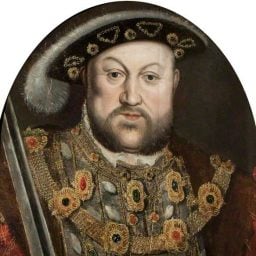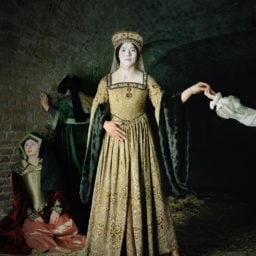Renaissance England is inseparable from the reign of King Henry VIII, the notorious monarch who famously had six wives—most of whom met unfortunate ends.
Initially married to Catherine of Aragon, Henry VIII (1491–1547) broke away from the Vatican and papal authority, naming himself head of the Church of England so he could annul the union and wed Anne Boleyn (mother of Queen Elizabeth I) in 1533. When he ultimately became dissatisfied with his union with Boleyn, he had her beheaded for treason so he could marry Jane Seymour, who died from complications of childbirth in 1537. After a few short years of bachelorhood, in 1540 he was wed to Anne of Cleves for just six months before again obtaining an annulment.
The year 1540 was also when arguably the most famous portrait of Henry VIII was created by the workshop of German painter Hans Holbein the Younger, the son of acclaimed painter Hans Holbein the Elder. Holbein was trained by his father and was an active member of the Basel artists’ guild, traveling through Switzerland, Italy, and France producing woodcuts, frescoes, panel paintings, and portraits for wealthy clients.
The rise of the Protestant Reformation across Europe, and the subsequent decline of commissions, led Holbein to travel to England, in 1526, with a letter of introduction from Dutch philosopher Erasmus to Sir Thomas More. After returning to Basel between 1528 and 1532, he journeyed to England once again, and within a few years, he became the court painter to Henry VIII.
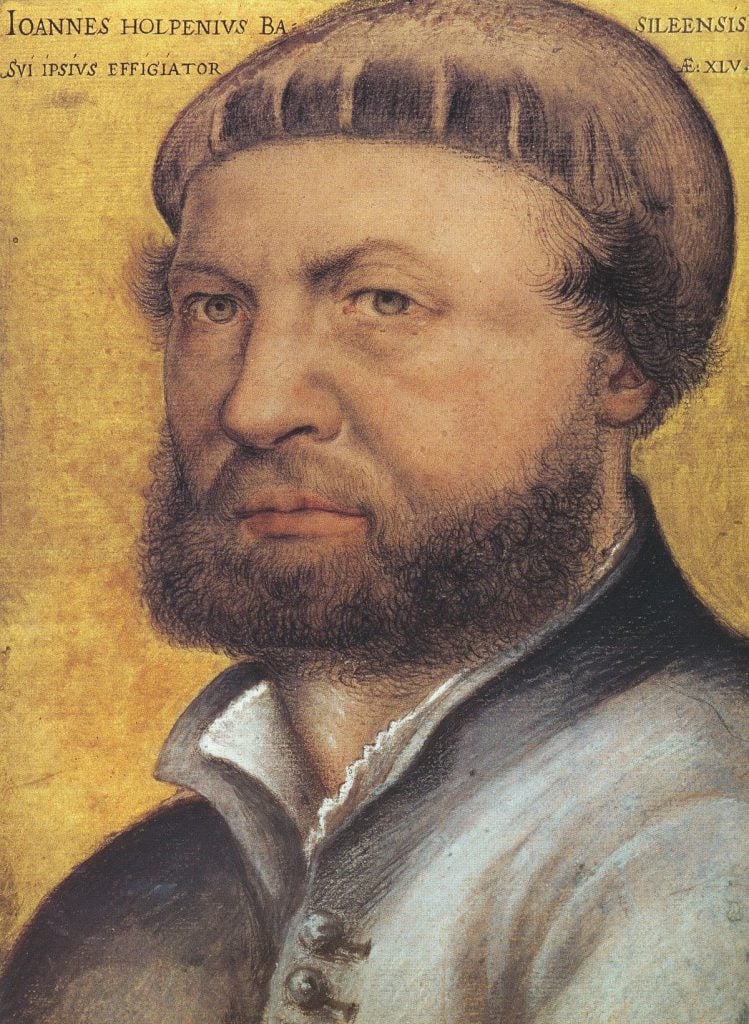
Hans Holbein the Younger, Self-portrait (ca. 1540–43). Collection of the Uffizi Gallery, Florence.
Known within the English court chiefly as a portraitist, he painted more than 100 miniatures and full-size portraits of courtiers and other notable figures, and his work has come to function as a primary documentary source of the Tudor period for historians. Among these works is the imposing, full-length portrait that has become emblematic of both the period and of the notorious, multi-wife king. (If you are curious about the wives that followed Anne of Cleves, next came Katherine Howard who, like her cousin Anne Boleyn, was also beheaded for treason, followed by Katherine Parr, who managed to outlive the king who died in 1547.)
Despite the absence of traditional symbols of the English monarchy—such as crown, orb, and scepter—the portrait unmistakably communicates that this is the most powerful man in the country at the time. With his wide and confident stance, unflinching stare, and sumptuous, bejeweled attire, Holbein conveys both the ruthlessness and absolute authority that was King Henry VIII.
Holbein’s portrait of Henry VIII is currently on view in “The Tudors: Art and Majesty in Renaissance England” at the Metropolitan Museum of Art, New York. Running through January 8, 2023, the exhibition offers a riveting glimpse into the art and culture of this singular period in English history, which continues to capture the world’s imagination to this day. In observance of this fascinating show, we looked closer at Henry VIII (ca. 1540) and discovered three fascinating facts about the famous portrait that you might not know.
The portrait is actually a copy of a mural that was lost in a palace fire
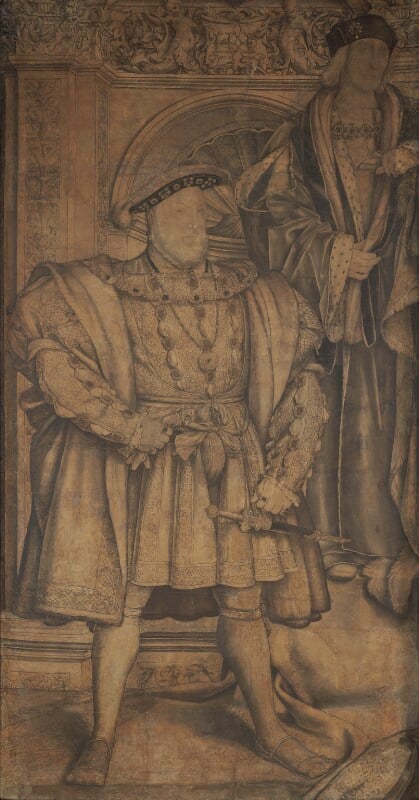
Hans Holbein the Younger, King Henry VIII; King Henry VII (ca. 1536–37). Collection of the National Portrait Gallery, London.
In honor of Tudor dynastic strength, Henry VIII commissioned Holbein to paint a multi-generational portrait on a wall of his residence, Whitehall Palace. The painting was finished in 1537 and featured Henry VIII and his then-wife Jane Seymour, as well as his father, Henry VII, and his mother, Elizabeth of York. Unfortunately, the work was destroyed when a devastating fire swept through the palace in 1698.
The original cartoon Holbein had created for the left-hand side of the work, however, has survived. It reveals that the portrait of Henry VIII made for the Whitehall palace mural was nearly identical to the full-length portrait from ca. 1540. The cartoon for the right-hand side has been lost to history. But the Flemish portrait painter Remigius van Leemput had meticulously copied the work in 1667, which allows historians to see what the full composition once was. That none of the iterations of the full-length portrait were done by Holbein’s own hand, and instead by his workshop assistants or emulators “after Holbein,” suggests that it was the strength of the composition and not necessarily the artist that was highly sought after.
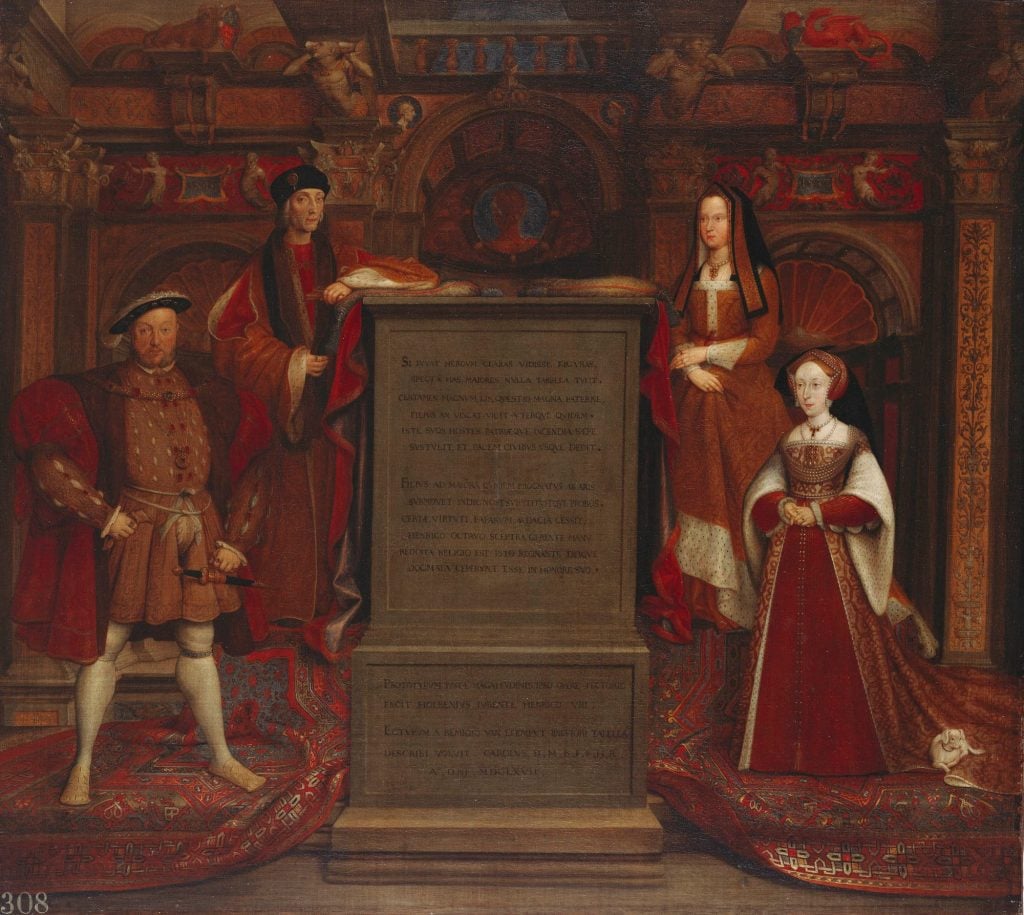
Remigius van Leemput, Henry VII, Elizabeth of York, Henry VIII and Jane Seymour (1667). Collection of the Royal Collection Trust, London.
In fact, there is only one portrait attributable to Holbein himself that is still extant, Henry VIII (ca. 1537), which is also on view in “The Tudors” exhibition. Regardless, the original wall painting and the full-length portrait speak to Holbein’s inimitable portraiture prowess, as the depiction of the king was not only extensively copied in the 150 years after its making, but continues to be considered a historical highpoint for the genre.

Hans Holbein the Younger, Henry VIII (ca. 1537). Collection and © Museo Nacional Thyssen-Bornemisza, Madrid.
Renaissance portraiture—early catfishing?
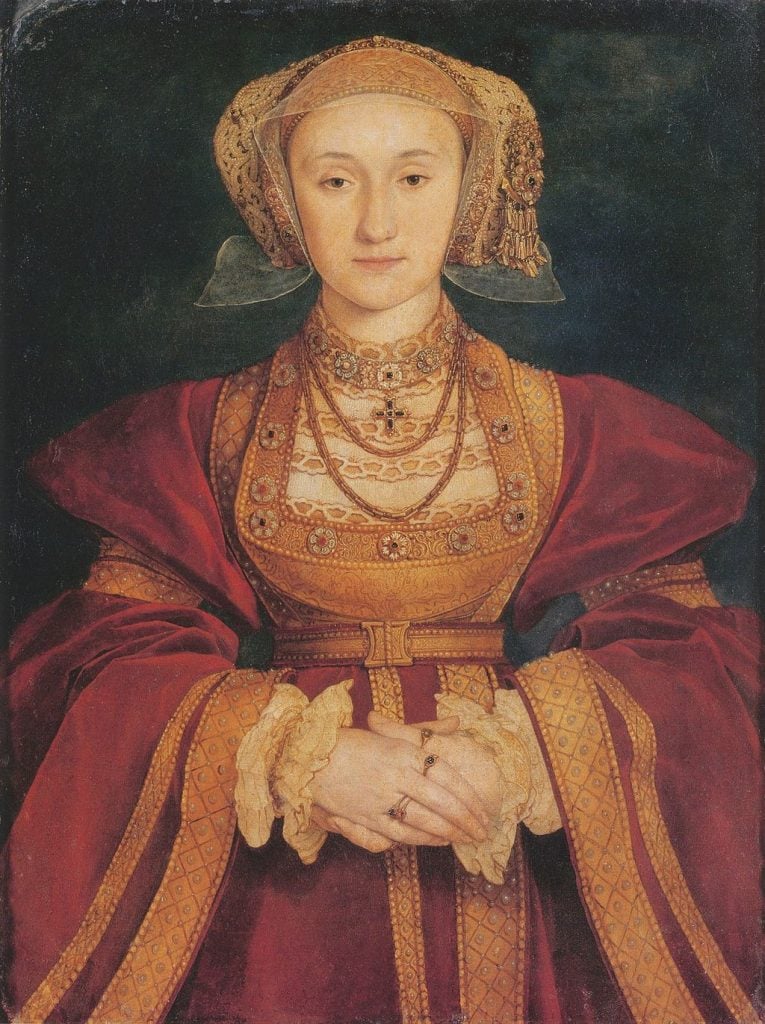
Hans Holbein the Younger, Portrait of Anne of Cleves, Queen of England, fourth wife of Henry VIII (1539). Collection of the Louvre Museum, Paris.
In January of 1536, the year before the completion of Holbein’s first portrait of the king, Henry VIII was in a catastrophic jousting accident that saw him trapped in full armor under his horse and, according to some records, unconscious for hours. The injuries he sustained, which some scholars have speculated included brain damage, ultimately became lifelong ailments that led him to become physically disabled and even more emotionally volatile.
His decreased mobility caused the once-active monarch to gain considerable weight, plus he also suffered from gout as well as venous leg ulcers that would sometimes burst. Although these maladies worsened after Holbein’s portrait commission, even at the time of its painting, Henry certainly did not possess the fit and brawny physique portrayed in the picture. A degree of beautification, however, could be expected for a monarch’s portrait, as these images operated in many ways as propaganda, using visual language to express the fortitude and resilience of the king’s reign.
Two years later in 1539, however, Holbein was commissioned to paint another portrait—this time of Anne of Cleves and her younger sister Amalia, both potential fourth wives for the king. Henry VIII instructed Holbein to make the portraits as true to life as possible, and upon seeing the picture of Anne, he chose her to be his bride. But after meeting her, Henry VIII complained that Anne’s portrait grossly exaggerated her beauty, and although he went through with the wedding, the marriage went unconsummated and she was cast aside. It is interesting to note, however, that the blame for the disaster was largely laid at the feet of Sir Thomas Cromwell, not Holbein, suggesting that Henry VIII understood the inclination to embellish a portrait.
Hans Holbein the Younger contributed to the Tudor aesthetic on the whole
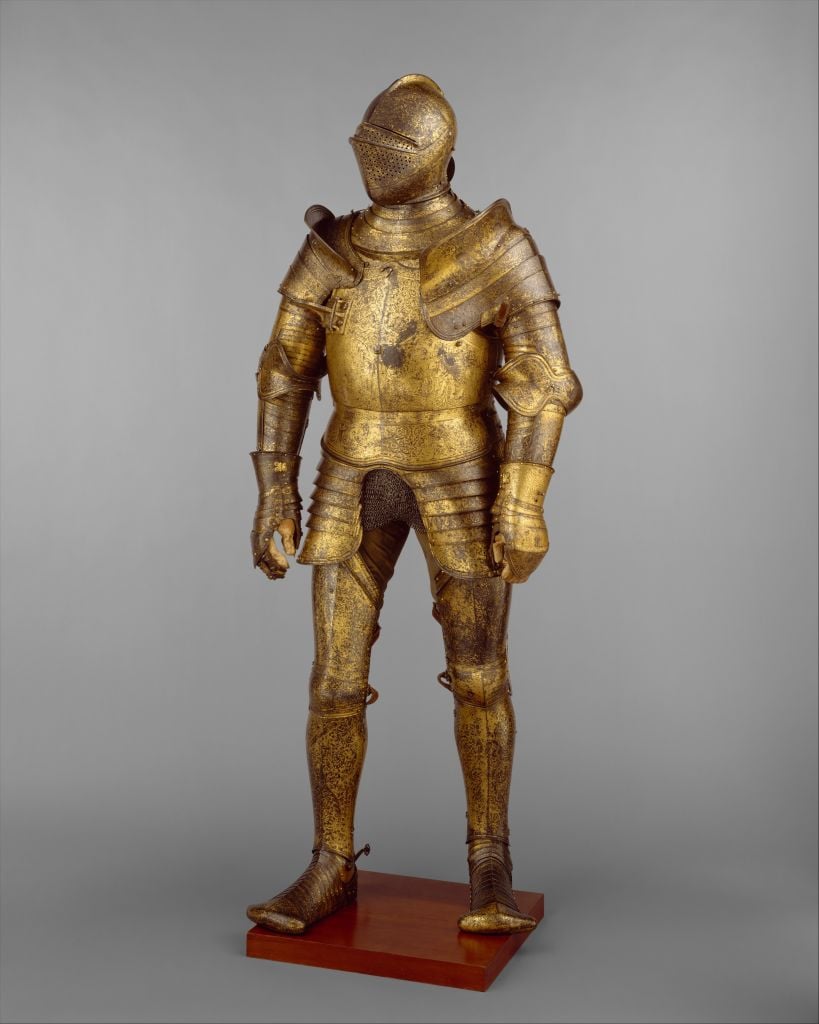
Hans Holbein the Younger, Armour Garniture, Probably of King Henry VIII of England (1527). Collection of the Metropolitan Museum of Art, New York. Photo: Heritage Art/Heritage Images via Getty Images.
Hans Holbein the Younger spent more than a decade at the court of King Henry VIII, and though he was best known then, as he is now, as a talented portrait painter, his skillset was incredibly wide ranging. Along with painting, Holbein was a prolific designer, creating everything from jewelry and buttons to pieces of clothing and ceremonial sword hilts, among countless other things. His designs were noted for their decorative and ornamental flare, featuring complex flora and fauna motifs, symbolism—and even the occasional merperson. In the full-length portrait of Henry VIII, we can see Holbein’s unique design aesthetic in the highly intricate patterns of the drapery, wall panel, and the king’s attire.
One of the most exquisite examples is a suit of tournament armor likely worn by Henry VIII, the design and decoration of which are attributed to Holbein. The fully articulated suit is notable not only for its decoration but also for its innovation; the ventral plate, which was typically worn above the breastplate is instead fastened to the chest, reducing the amount of weight carried by the shoulders.
Holbein’s jewelry designs, which feature in many of his paintings, have led to a genre of the craft being named after him: Holbeinesque jewelry. This style of jewelry design is recognizable for its unreserved opulence and extravagance; pieces are laden with large precious and semiprecious gemstones and feature elaborate metalwork. It is the type of jewelry one has come to expect to see in English Renaissance portraits of court ladies and royalty.
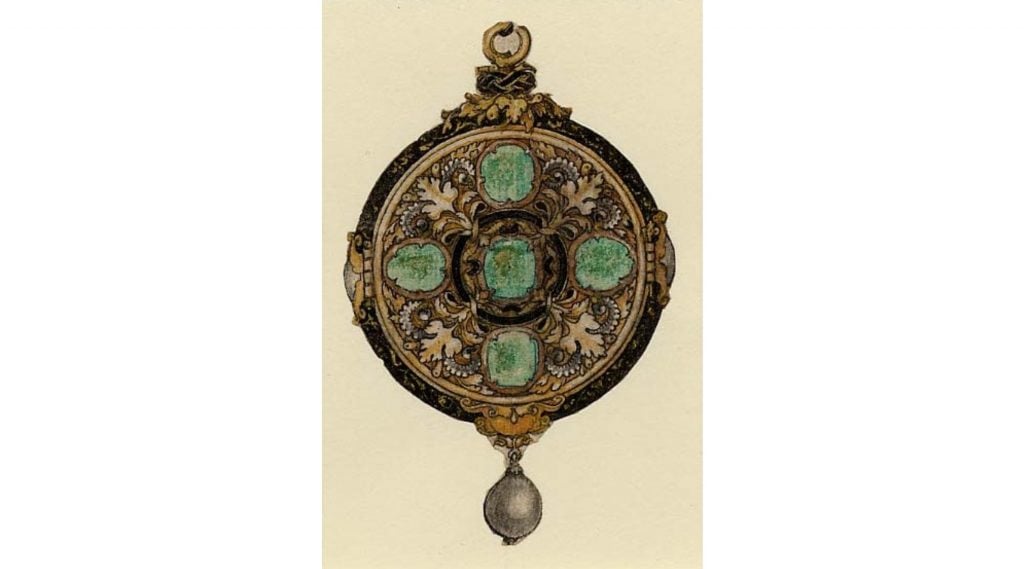
Hans Holbein the Younger, Design for a circular pendant set with five emeralds and a single suspended pearl. One of nine designs for pendant jewels, from the “Jewelry Book” (ca. 1532–43). Collection of the British Museum, London.
“The Tudors: Art and Majesty in Renaissance England” is on view at the Metropolitan Museum of Art through January 8, 2023.










